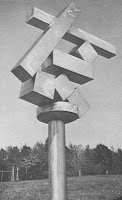Chatsworth House in Derbyshire, the home of the Duke of Devonshire, is one of Britain’s most magnificent country houses, architecturally and in its setting. The Duke has a keen interest in modern art and works from his collection are on loan at present to the Lucien Freud exhibition at the NPG. Currently 15 sculptures by Sir Anthony Caro are on display at Chatsworth, sited around the Canal Pond and its famous Emperor Fountain, in front of the south façade. The works which date from 1960 to the mid-1990s are on loan from the sculptor.
 |
| Goodwood Steps (1994-6) |
In the catalogue (good value at £10) Martina Roth from the Yale Center for British Art explores the relationship of Caro’s work with that of Smith and Moore. She also considers his somewhat ambiguous preferences for his work to be “unpublic” and to be seen “indoors” - which would be more like his Early One Morning (1962) when shown at the RA last year:
than Sculpture Seven (1961) at Chatsworth:
and clearly was never his intention for Goodwood Steps. Other works are representative of his ‘flat’ style of the 1970s and his later more solid pieces (Cliff Song (1976) and Forum (1992-4) below, left and right).
Caro at Chatsworth continues to 1 July.
Frank and Cherryl Cohen at Chatsworth
Inside Chatsworth House, in the New Gallery, but unfortunately only until 10 June, is the first public display of Frank and Cherryl Cohen’s collection of modern British art built up during their 40 year marriage.
In a post here last March, Social Mobility and the Conscience of the Rich, I commented on some work done by the Resolution Foundation, and concluded:
What should rich men with a conscience and a broader interest in society than making money out of it do with their money? Of course it’s up to them if they want to set up think tanks to investigate hobby-horse issues. (Personally I would want to emulate Bryan Ferry and collect modern British art!)It’s difficult to imagine someone being more upwardly mobile than Frank Cohen who started on a market stall and now mixes with leading artists and the Duke of Devonshire. He and his wife have lent 40 paintings and sculptures from their collection for the exhibition at Chatsworth. Among the items on display which I admired are Stanley Spencer’s Christ Preaching at Cookham Regatta: Conversation between Punts (1956), Sickert’s The New Bedford (1915), and Auerbach’s Head of William Feaver (2010). John Minton’s Cornish Coast (1945) (left) has an obvious SW England connection.
The catalogue is excellent value at £9.95 and includes an Introduction by Howard Jacobson (excerpted in the Daily Telegraph) and an account of a conversation between the curator of the show, Robert Upstone, and the Cohens (left). No doubt they will be pleased to see their collection back in Wilmslow in their Mies van der Rohe style house (interview with Jackie Wullslager in the Financial Times (£)). But hopefully some or all of it will be lent again in the coming years. An ideal gallery would be Bath’s extended Holburne Museum, which would allow more space for the larger works to be appreciated than the New Gallery at Chatsworth could provide.






No comments:
Post a Comment